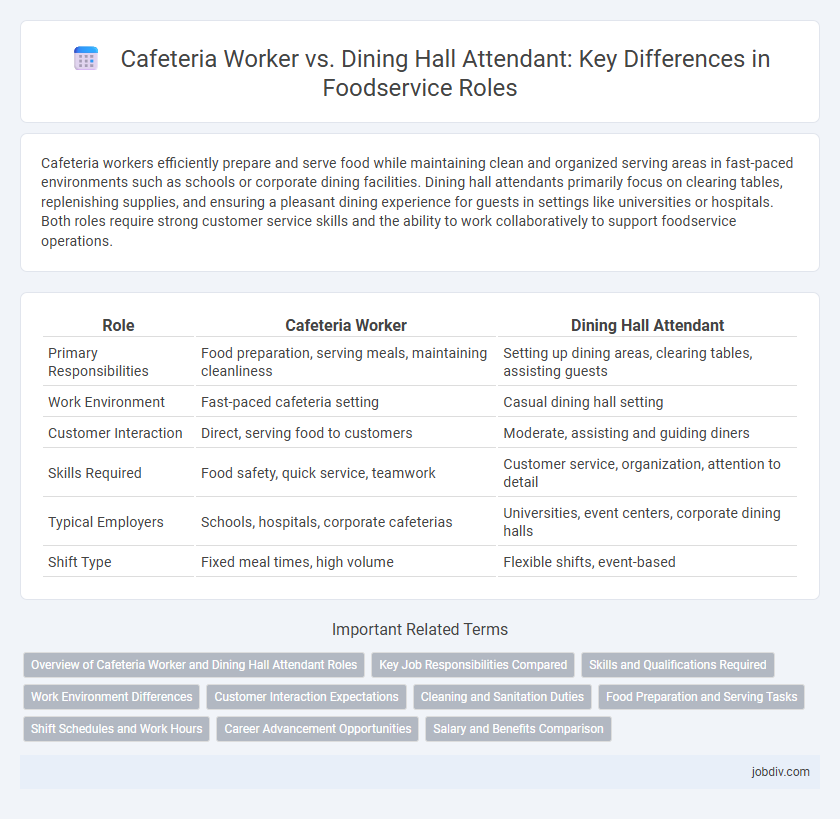Cafeteria workers efficiently prepare and serve food while maintaining clean and organized serving areas in fast-paced environments such as schools or corporate dining facilities. Dining hall attendants primarily focus on clearing tables, replenishing supplies, and ensuring a pleasant dining experience for guests in settings like universities or hospitals. Both roles require strong customer service skills and the ability to work collaboratively to support foodservice operations.
Table of Comparison
| Role | Cafeteria Worker | Dining Hall Attendant |
|---|---|---|
| Primary Responsibilities | Food preparation, serving meals, maintaining cleanliness | Setting up dining areas, clearing tables, assisting guests |
| Work Environment | Fast-paced cafeteria setting | Casual dining hall setting |
| Customer Interaction | Direct, serving food to customers | Moderate, assisting and guiding diners |
| Skills Required | Food safety, quick service, teamwork | Customer service, organization, attention to detail |
| Typical Employers | Schools, hospitals, corporate cafeterias | Universities, event centers, corporate dining halls |
| Shift Type | Fixed meal times, high volume | Flexible shifts, event-based |
Overview of Cafeteria Worker and Dining Hall Attendant Roles
Cafeteria workers primarily focus on food preparation, serving meals, and maintaining cleanliness in fast-paced, self-service environments, ensuring efficient food distribution to customers. Dining hall attendants typically manage dining room setups, assist with seating, and provide general customer service in larger institutional settings, enhancing the overall dining experience. Both roles require strong communication skills, attention to hygiene standards, and the ability to work collaboratively in foodservice operations.
Key Job Responsibilities Compared
Cafeteria Workers primarily focus on food preparation, serving meals, and maintaining cleanliness in fast-paced environments such as schools or corporate settings, ensuring efficient food distribution and adherence to health standards. Dining Hall Attendants are responsible for setting up dining areas, assisting guests with seating, refilling food stations, and monitoring dining room cleanliness to enhance guest experience in institutional or campus dining halls. Both roles require strong customer service skills but differ as Cafeteria Workers emphasize food handling and safety, while Dining Hall Attendants focus on facility presentation and guest support.
Skills and Qualifications Required
Cafeteria workers require strong customer service skills, basic food safety knowledge, and the ability to operate kitchen equipment efficiently. Dining hall attendants need excellent multitasking abilities, thorough understanding of sanitary regulations, and effective communication skills to manage large groups during meal service. Both roles demand physical stamina and attention to detail for maintaining cleanliness and timely food delivery.
Work Environment Differences
Cafeteria workers typically operate in fast-paced school or corporate settings, managing large volumes of meals during peak hours with standardized menus. Dining hall attendants often work in collegiate or institutional dining environments, where they provide more personalized service and maintain consistent food presentation and cleanliness throughout extended meal periods. The cafeteria work environment emphasizes efficiency and rapid food distribution, while dining halls prioritize atmosphere and guest interaction.
Customer Interaction Expectations
Cafeteria workers typically engage in direct customer service by taking orders, answering menu questions, and handling transactions, ensuring a personalized dining experience. Dining hall attendants focus more on maintaining cleanliness, restocking supplies, and assisting customers with seating or basic requests, emphasizing efficient service flow. Both roles require strong communication skills, but cafeteria workers prioritize interactive, face-to-face engagement while dining hall attendants support a smooth operational environment.
Cleaning and Sanitation Duties
Cafeteria workers prioritize cleaning tasks such as sanitizing food preparation surfaces, washing dishes, and maintaining kitchen hygiene to prevent contamination. Dining hall attendants focus on clearing tables, sweeping floors, and ensuring dining areas remain sanitary and presentable for guests. Both roles require strict adherence to health and safety regulations to support overall foodservice sanitation standards.
Food Preparation and Serving Tasks
Cafeteria workers primarily focus on food preparation duties such as assembling ingredients, cooking menu items, and ensuring portion control to maintain quality and consistency. Dining hall attendants emphasize serving tasks including setting up dining areas, replenishing food stations, and assisting customers with meal selections. Both roles require adherence to hygiene standards and efficient handling of food to support smooth operation in foodservice environments.
Shift Schedules and Work Hours
Cafeteria workers typically have fixed shifts concentrated around meal times, often covering breakfast, lunch, and dinner service hours. Dining hall attendants may work extended or rotating shifts that include early mornings, late evenings, and weekends to accommodate broader campus or institutional dining operations. Both roles require flexible availability, but dining hall attendants often experience more variable and longer work hours due to the continuous service model.
Career Advancement Opportunities
Cafeteria workers often gain experience in food preparation and customer service, which can lead to roles such as kitchen supervisor or foodservice coordinator. Dining hall attendants typically develop strong skills in facility management and guest relations, opening pathways to positions like dining services manager or event coordinator. Both roles provide foundational experience that supports career advancement within the foodservice industry.
Salary and Benefits Comparison
Cafeteria workers typically earn an average hourly wage between $12 and $15, with benefits such as health insurance and paid time off varying by employer. Dining hall attendants often receive a similar wage range but may have access to additional perks like meal discounts and flexible scheduling. Salary differences are minor, making benefits and work environment the key factors when comparing these foodservice roles.
Cafeteria Worker vs Dining Hall Attendant Infographic

 jobdiv.com
jobdiv.com